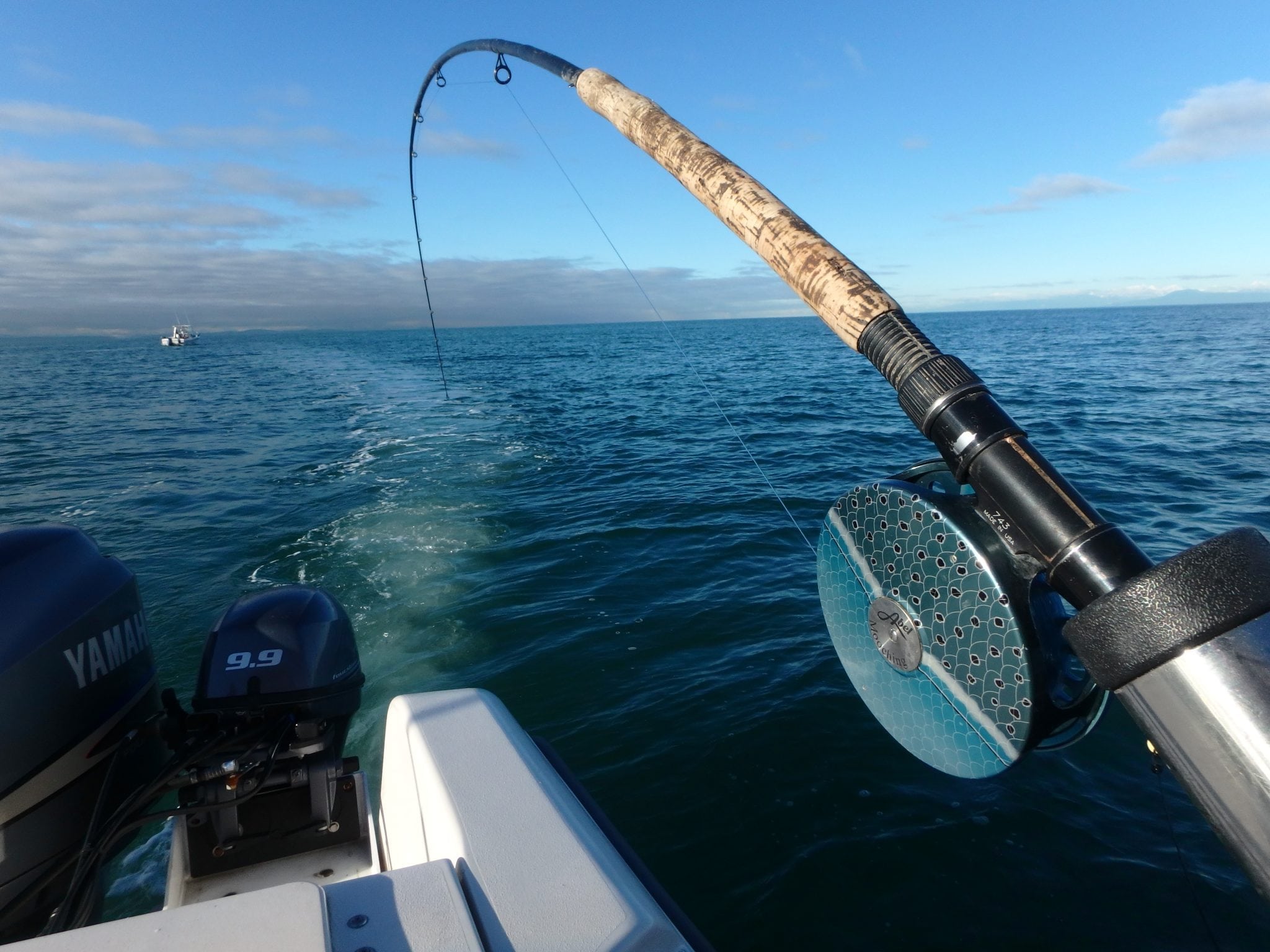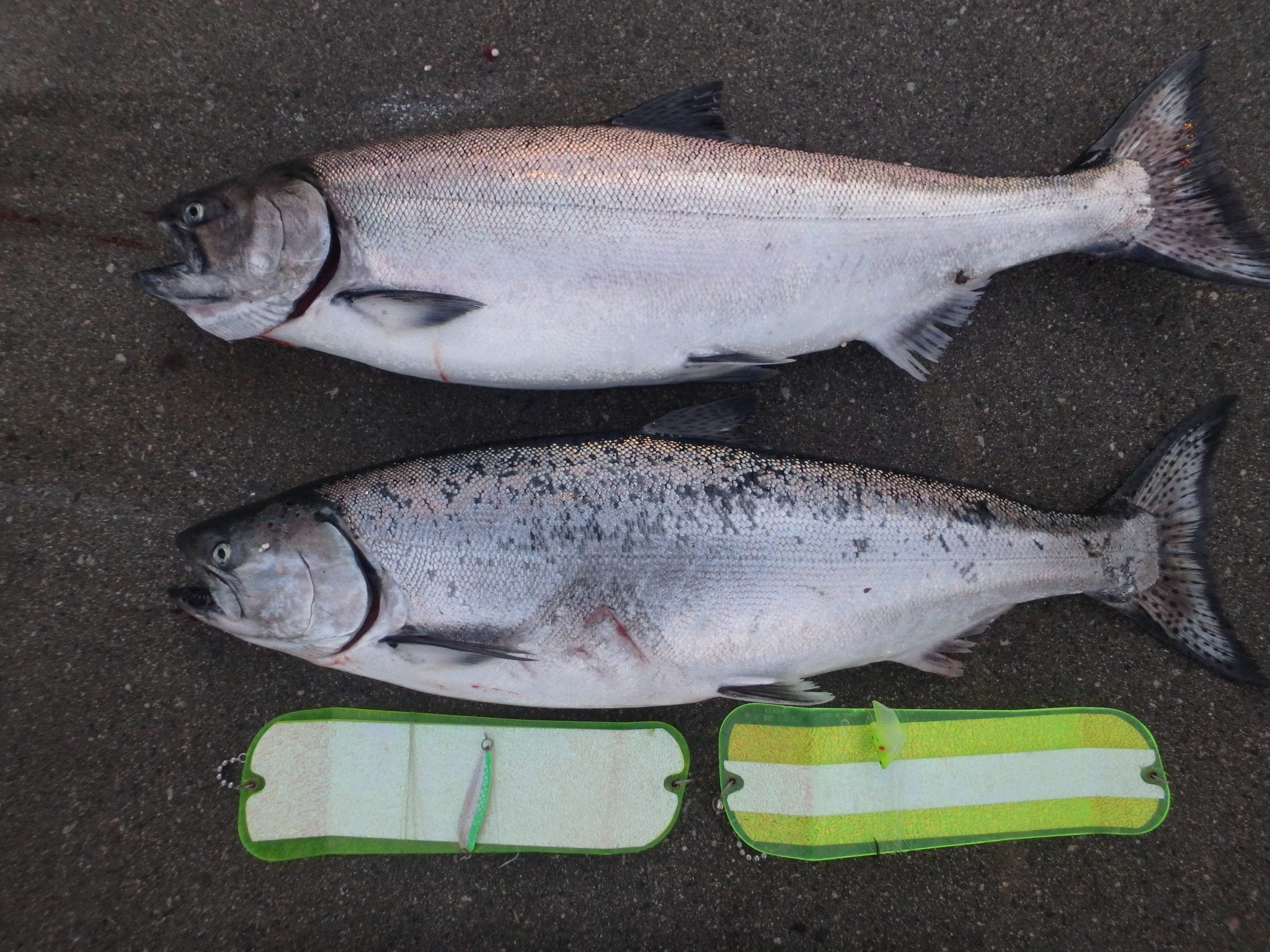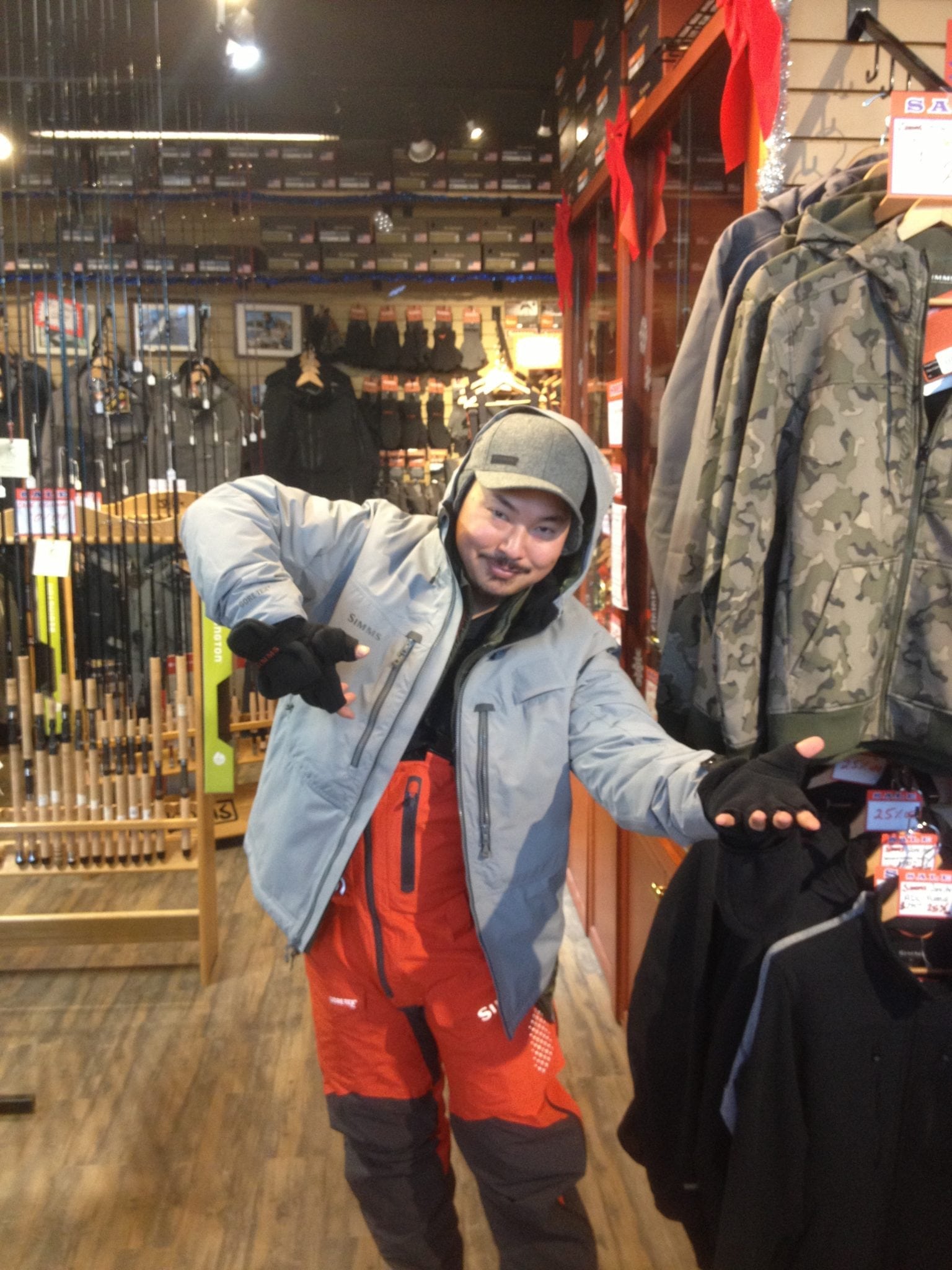OUTLOOK
Happy New Year from Pacific Angler! With Friday falling on the first day of the year we wanted a Friday fishing report that starts off 2016 right. We have lots of information and a new video for you this week.
The forecast looks cold and clear for the weekend. With this in mind Jordan has written the ultimate layering guide to keeping warm on the water. Check it out at the end of the report. We still have a number of great deals on warm weather clothing carried over from our Boxing Week sale so there has never been a better time to stock your wardrobe with the best cold weather fishing apparel.
Another big announcement this week is that our full 2016 course schedule is up on our new website and we have some awesome courses in January that still have availability.
There is a NEW fly tying course focused on essential steelhead patterns, Andre has his Beginner Fly Tying Course and we are featuring two on the water fishing courses, Matt’s famous Fly Fishing Egg Patterns Course and our often imitated never duplicated Pacific Angler Steelhead Float Fishing course. Both of these courses are a great way to get out on the water with the pros and make sure you are doing it right for the upcoming season.
To make things interesting we have included our video on Advanced Mending – the one we use in our egg fishing course. Check it out for some cool footage and some great examples of advanced mending. Don’t forget to register for the course!
On to the fishing!! For river fisherman, cold, clear weather posses a number of challenges. The rivers will be low and clear and the fish will be picky. That said there is no better time to scout because you have ample shore space to hike and cross the rivers. The clarity also helps you spot good holding water. The river fishing will not be hot this weekend but for those who plan to head out focus on finding spots so you will know where to fish when the rivers rise and warm up. Check out the river reports for both steelheading the Vedder River and trout fishing the Squamish River.
Another great opportunity this time of year is winter chinook out in the harbour. We are hearing good fishing reports and the crabbing and prawning has been excellent. Jason was out on the water Wednesday so check out the saltwater report below for the details.
The long-term forecast is also worth looking at this week. The conditions may not be ideal for the weekend but leading into next week we are going to see an increase in temperatures and some precipitation. Watch the weather closely. This could be the first bump of water of the new year and with it fishing should light up for both fresh steelhead moving into systems and an increase in feeding activity from the resident trout waiting for salmon eggs to be flushed out of the rocks. The longer the cold spell leading up to a warm spell the better the fishing.
On another note if you are going to stay home and keep warm this weekend, we have updated out website with some awesome pictures and all of our videos from 2015. Check out the Pacific Angler Media Library ,now live on our site.
Good Luck out on the water!
COURSES
Fly Fishing Egg Patterns
This course is designed to teach you the secrets to one of the most productive presentations in the BC fly fishermen’s arsenal; nymphing egg patterns. This deadly method can be used for different species of trout, char, and salmon. During a 3-hour evening seminar we will teach you key concepts, strategies, and gear that will give you a well-rounded foundation during the seminar portion of the class. Then you will put those skills into practice during a fully guided day on the water.
Dates: Seminar: Jan 11 Guided: Jan 16 or 17
Seminar Time: 6:30pm – 9:30pm
Cost: $250.00
Tying Essential Steelhead Patterns
This course is designed for the fly tyer looking to get the best start on tying steelhead patterns. In the 3-hour evening seminar your instructor will cover everything from tying techniques, material and colour choices, size and weight. They will walk you through 3 essential patterns that will build a well-rounded steelhead fly box. If you’re looking to get yourself into tying your own flies for steelhead, this is the course for you. This course is suitable for fly tiers with a basic knowledge. Students are required to supply their own vise, tools and materials. A 10% discount is available on materials and tools purchased for the course.
Date: Jan 12
Time: 6:30pm – 9:30pm
Cost: $45.00
Steelhead Float Fishing
In this fishery, 10% of the anglers catch 90% of the fish. This is your chance to learn from the 10%! Our 3hr evening seminar will educate you on the gear, water types, conditions and other key variables that put veteran steelhead anglers in that 10%. Mastering this fishery will make you the envy of your friends. Upgrade your seminar to include a fully guided day on the water, putting into practice your new knowledge with a Pacific Angler guide.
Dates: Seminar: Jan 13
Guided: Jan 16, 17, 23 or 24 (custom trip dates are available)
Seminar Time: 6:30pm – 9:30pm
Seminar Only Cost: $45.00
Seminar & Guided Walk’n Wade Cost: $250.000 per angler, minimum of 2 anglers per guided day on the water.
Introduction To Fly Tying
There is no greater satisfaction than catching a fish with a fly you tied yourself. This course was specifically designed to give you the fundamental skills needed to tie proven fly patterns used here in BC for trout, salmon, and steelhead. This course consists of 3 sessions; each session is 3hrs. Students are required to supply their own vise, tools and materials. A 10% discount is available on materials and tools purchased for the course.
Dates: Jan 18, 25 & Feb 1
Time: 6:30pm – 9:30pm
Cost: $75.00
FRESHWATER REPORTS
Squamish
Well, if you saw my last report on how to look at river conditions and plan a day on the water, you will know that things are going to be challenging this weekend. Expect very low clear water levels on the entire Squamish system. There are three things to focus on in these conditions; sight fishing, ultra subtle small presentations, and scouting.
When I am out in conditions like this I pick very pale beads with ultra thin leaders. Make everything as stealthy as possible. Break out the small indicators, and 5lb fluorocarbon. The other thing I focus on is scouting. I try to see as much of the river as I can and cover areas were you might not have been able to reach in high water. This is a win win scenario. The fish in these areas are less pressured and more likely to bite and the knowledge you gain will pay dividends on future trips. The other thing you see me doing it staring at runs looking for changes in the bottom of the run or deep spots that I might have missed in higher water. Again, knowing where these spots are will pay off in the future and while doing it I usually spot quite a few fish. Once I have spotted a fish in these conditions it is hard to get them to bite because their metabolisms have slowed right down but if you can put a bead it right in front of them they will usually bite and there is nothing cooler than watching a fish eat.
Good Luck on the water and watch the forecast for things to change. The longer the cold spell the better the fishing when it finally warms up.
Matt.
Chehalis
The river will remain low until the next big rainfall and fishing will be very tough. This river runs clear at the best of times, so with a good cold snap like we are getting right now, it is very, very clear. Some of our other rivers are likely a better option. If you do decide to go, keep your presentations very small. Use smaller floats and clear floats as they tend to be more subtle and won’t spook the fish. Also try smaller split shot, fluorocarbon leaders and smaller hooks like size #2 or #4. Keep your offering very small, the size of a single egg is perfect. If you are fly fishing use longer leaders and very small flies.
Vedder
With the colder temperatures and lack of precipitation the river will continue to drop and visibility will increase. It is already quite clear throughout the river. Downsizing your presentation is critical. Switching from monofilament to fluorocarbon leader material will also make a big difference in these conditions as fish will be more alert and wary. Fishing smaller and subtle presentations such as single eggs, wool ties, and boraxed roe are a few of the go-tos for this time of year. There have been a few reports of fish throughout the river but it’s just the beginning of the season. With the expected lower water fish will trickle in the system slowly.
Stave
With the predicted weather expected to shape up the rivers in the next little while, those who have been prepping for steelhead should be the first ones rewarded. With a handful of spots to hold these fish, those who explore usually do quite well once they are located. When it comes to these early season fish, think pink!
These fish are also quite trouty, and are often accidentally caught while nymphing small stoneflies or tossing small spinners or spoons for the many resident trout and whitefish as well.
Please remember to assume every fish is wild, and to keep all wild fish wet and do not drag fish that are to be release up onto the shore.
Jordan
SALTWATER REPORT
Finally the rain and wind backed off and our guides were able to get out and chase down some winter chinook! As mentioned in last weeks report, so far so good, as we are getting good reports pretty much from Campbell River down to Washington.
We landed these two nice fish by keeping our gear close the bottom and covering lots of water. One of the keys to doing that is trolling fast and we recommend 18 LB cannonballs to keep the gear down on a fast troll.
Last year we had some exceptional winter chinook fishing in early to mid January so if you would like to book a trip, please contact us now so we can pick the best tides for you. Email Jason at jtonelli@pacificangler.ca
If you are heading out on your own, take a look at previous reports for detailed information on what flashers to use and what lures to use or drop by Pacific Angler and we will get you dialed in!
See you on the water or in the shop!
Jason
PROPER LAYERING FOR COMFORT AND WARMTH
Jordan Simpson
Bright skies, clear water, and frosty mornings all mean one thing- winter is here!
With winter comes cold weather- regardless of the shining sun. A lot of people mistake sunny skies for warm weather and are often caught unprepared for what Mother Nature is offering.
One of the biggest issues overlooked during this time of the year is proper layering- not just for comfort, but for health and safety. Layering too much and improperly will mean you sweat, creating damp clothing and unwanted chills, often leading to a numb body or the dreaded next-day cold. Layer too little and your body has to work in overdrive to keep your blood regulated and your body warm. Layer properly and you won’t have to worry about it. You will be comfortable and focused, leading to a more enjoyable and hopefully productive day on the water. This goes for both river and saltwater anglers alike.
In the heat of the summer, as you sweat, a cool breeze feels ever welcomed. Sweat is mostly water with some salt (sodium chloride). It is produced by the sweat glands and pours out onto the surface of the skin. Here the water evaporates, which removes heat from the skin through convection, therefore cooling the skin down.
But what happens when it’s freezing cold outside and you’re not wearing a t-shirt? Where does that sweat go, and how do you get it to ‘evaporate’ under all those layers? The answer is proper layering. And that starts with, you guess it, the next-to-skin base layer.
This layer, being next to your skin, is going to be the first piece of layering that touches sweat. The ability to absorb moisture and then push it outwards is key. Being next to the skin, you want it to absorb and then transfer moisture away from your skin, wicking it outwards towards the air where it can evaporate. To do this, and it needs to be non-absorbent so it doesn’t hold the moisture. Options to consider, which I’ve had years of first-hand experience in using, is the Waderwick series from Simms. I’ve used both the tops and bottoms with great comfort and success. These pieces are light, non-absorbent, and feel great next to the skin.
Up next is your mid-layer. This layer is your absorption and semi-insulating layer that helps regulate your temperature as well as helps dissipate all that moisture and in turn, helps dump excess heat. Though many synthetics claim to offer this ability, nothing compares to the natural moisture/weight ratio of wool. Key characteristics of wool include, but are not limited to:
- Breathability – Wool fibers can absorb large quantities of moisture vapor and then transfer it through evaporation into the air, keeping the skin fresher and drier for a longer time.
- Temperature regulation – Wool provides a personal ‘air-conditioning’ system to maintain temperature regulation through its natural crimp, which creates a lot of very small insulating air pockets.
- Odour resistance – Wool’s breathability helps to reduce sweat and odour, keeping the wearer’s skin drier and cleaner. The fibre’s complex chemical structure locks away odor only releasing it upon washing.
- Elasticity – Wool is naturally elastic and sheds creases due to its unique structure and crimp: at microscopic levels,fibres are like coiled springs, returning to their original state when the stretch and extension through wear and movement is released. This helps to maintain the garment’s shape and quality.
- UV protection and fire resistance – Wool offers a natural protection from ultraviolet light and is fire resistant and stores less static in comparison to other fibers. No synthetic fiber can guarantee the same benefits and comfort.
Great options to consider this winter are the Montana Wool series of tops and bottoms, sourced from Montana sheep. This wool is sourced, spun, and then turned into garments in the US guaranteeing top quality. With both top and bottom pieces offered from Simms, this is your next step.
Okay, so you’ve got that comfy layer next to your skin paired with a moisture and heat dumping layer helping you get rid of excess sweat- but what comes next? The answer: insulation; and more importantly, staying warm.
To help stay warm, you need to trap dead air. This dead air is what warms up, keeping you warm. As ironic as it sounds, when you get the chills and you can feel your hairs stand on end (goosebumps), this is your body trying to stay warm. As your body stands your hairs up on end, it creates areas for air to get trapped and naturally warm up. When trying to cool down, your hairs lay flat, allowing for air/wind to travel across your skin and to help cool it down through convection (as we learned about above).
When people think of warm, they often think of fleece, and for good reason. Fleece is quite often made up of recycled plastic bottles, or soft napped insulating fabric made from a type of polyester called polyethylene terephthalate (PET) or other synthetic fibers. This allows it to maintain its structural shape, aiding in creating micro-chambers of dead space- and most importantly, air.
One of our favorite pieces for those cold days is the Simms Guide Mid Top. Clean-cut lines and articulated elbows also aid in rowing and casting, making this one of our go-to pieces.
On top of all of this, we wear our shells. These shells help protect all of this from the rain and wind, as well as help keep ourselves hidden and blended into our surroundings, making it harder for the fish to see when wading shallow rifles and runs, or standing over glassy frog-water.
For those who’s pescatorial pursuits take them onto the salt, these outer layers keep us protected from the salt and keep us dry from those days that bring sideways rain.
-Jordan Simpson







